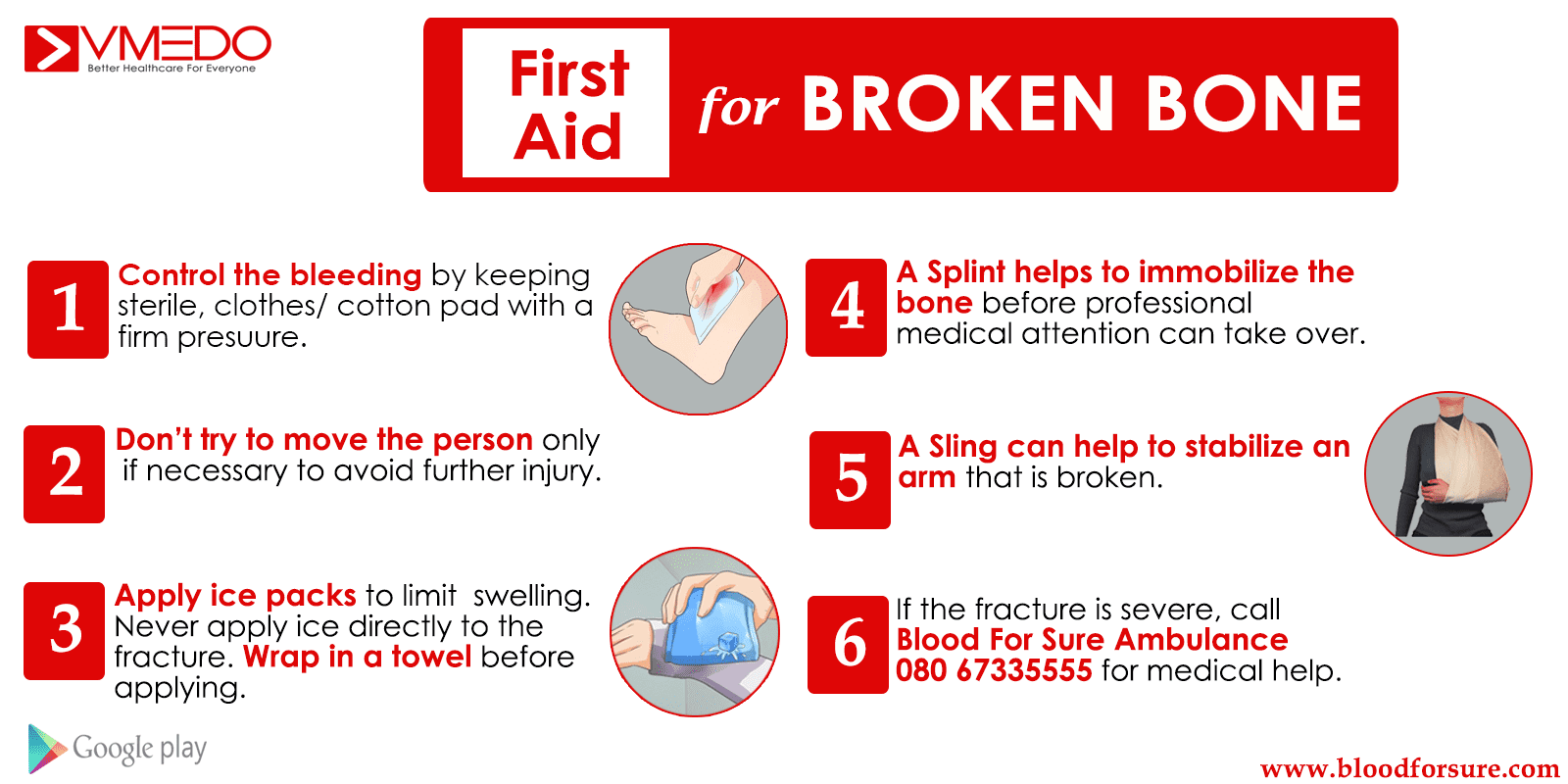Broken Bones
First Aid For Broken Bone:
- Control the bleeding by keeping sterile, clothes /cotton pad with a firm pressure.
- Always keep the injury area in antigravity direction to Blood loss.
- Do not let the person bear any force on the fracture.
- Don’t try to move the person only if necessary to avoid further injury.
- Apply ice packs to limit swelling and help relieve pain. Never apply ice directly to the fracture. Wrap the ice in a towel, a piece of cloth before applying.
- Treat for shock. If the person is breathing in short, rapid breaths feel faint help the person to lay down &, if possible, try to elevate the legs.
- It can be difficult for a first aider to decide the type of injury is. So always treat the injury like a fracture.
- Never massage the affected area at the moment of injury.
- If the injury is severe call VMEDO medical Emergency number 09343180000.
Causes:
The most common causes of a broken bone include:
- Motor Vehicle Accidents: The crushing injuries common in vehicle accidents may cause breaks that require surgical repair.
- Falls: falling or tripping can break bones in your legs or hands.
- Missteps: Sometimes just Missteps or bad fall can result in a broken bone.
- Osteoporosis. This disorder weakens the bones and makes them more likely to break.
- Age: If you’re 60 years or older, you may be at increased risk of breaking your bones.
- Sports: Some sports can result in the broken bone.
Also Read: 9 First Aid tips you should know in case of road accidents
Fracture Prevention:
Workouts:
Your Workouts should include building muscle as muscle works as a great bone protector but take precautions in keeping them safe from injury & withstand stress. Don’t forget to warm up before playing sports or working out and to stretch afterward.
Prevent Falling: Some tips to help prevent falls are:
- Wear rubber-soled shoes so you don’t slip
- Keep rooms free of clutter, especially on floors
- Use plastic or carpet runners
- Wear low-heeled shoes
- Do not walk in socks, stockings, or slippers
- Use a cane or walker.
- be sure stairs are well lit and have rails on both sides
- Use a non-skid bath mat in the shower or tub
Healing/Cure:
Tips to help a Broken Bone Heal Faster:
Consult your doctor immediately: If you experience significant trauma (fall or automobile accident) and feel severe pain, with any cracking sound or swelling — then head to the nearest hospital for better medical attention.
Managing a Fracture at Home:
Once you’re discharged, you might need cane or crutches for support. Total bed rest is not a good idea for most fractures because some movement is needed to stimulate blood flow and better healing. Ice should be applied for 10-15 minutes every once in 3 hours for a couple of days.
Frequently Asking Questions:
- How do fractures or broken bones occur?
Normally, when an outside stress is applied to the bone, & it returns to its normal shape when the stress stops. However, if the stress is too strong, the bone will crack or break.
- How long does it take a fracture to heal?
The timeline to heal the fracture is depending upon the severity of the fracture, the type of bone affected & area of the fracture. For most of the fractures, it takes from few weeks to several months.
- How are fractures treated?
Commonly, a plaster or fiberglass is cast, which stabilizes the broken bone during its healing. For few fractures, doctors use functional casts for controlled movement. Severe fractures may require surgery, where doctors may insert screws to hold the bones or attach plates to the outer surface of the bones.
- What should I do if my child breaks a bone?
A broken bone or dislocated joint is a serious injury. The immediate action protects the injured area, making sure your child doesn’t worsen the damage & consult a doctor.
- What are the most common causes of fractures?
The most common causes of a broken bone include:
- Motor Vehicle Accidents: The crushing injuries common in vehicle accidents may cause breaks that require surgical repair.
- Falls: falling or tripping can break bones in your legs or hands.
- Missteps: Sometimes just Missteps or bad fall can result in a broken bone.
- Osteoporosis. This disorder weakens the bones and makes them more likely to break.
- Age: If you’re 60 years or older, there is an increased risk of breaking your bones.
- Sports: Some sports can result in the broken bone.
6. How Can I Keep My Bones Healthy?
Healthy diet & exercise can keep your bones healthy. Here are few ways to protect your bones are:
- Get enough calcium and vitamin D each day.
- Walk, climb stairs, lift weights, or dance each day.
- Talk with your doctor about having a bone mineral density (BMD) test.
- Talk to your doctor about taking medicine to make your bones stronger.
For any medical emergency including Ambulance, blood requirement call for VMEDO helpline 093431 80000
If you are looking for first aid, CPR, AED, and Basic Life Support training program Click here and Register.
